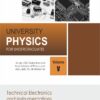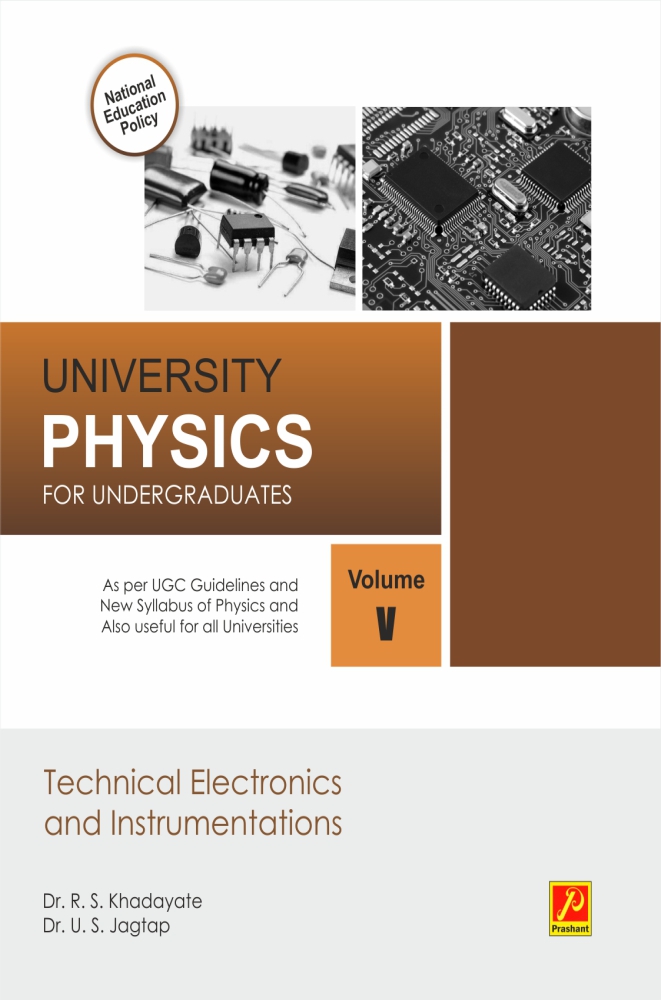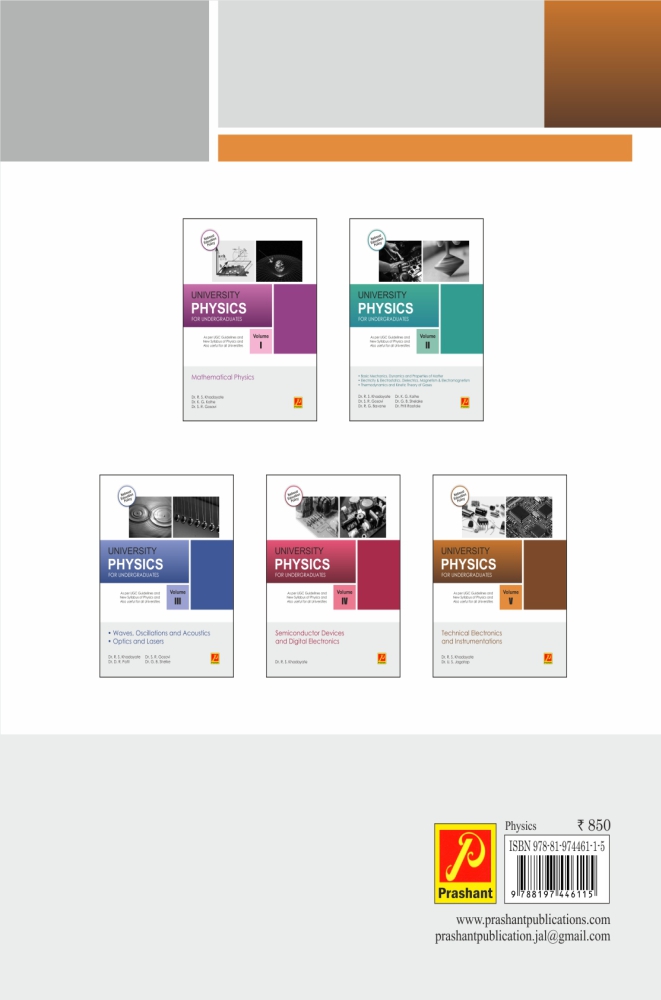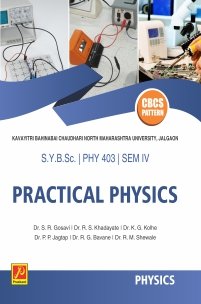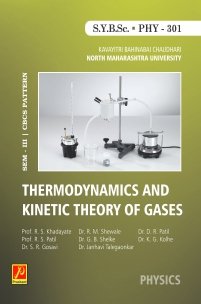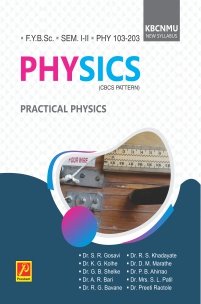University Physics for Undergraduates
(Volume V)
Authors:
ISBN:
₹850.00
- DESCRIPTION
- INDEX
Physics is the fundamental science that seeks to understand the natural laws governing the universe. Its principles form the basis for countless technological advancements and scientific inquiries that shape our world. This reference book aims to serve as a comprehensive guide for students, educators, and professionals who seek to deepen their understanding of this dynamic field.
We are very glad to present this book “University Physics for Undergraduates (Volume-V)”. Our objective in creating this book is to offer a detailed and systematic knowledge related to topics Technical Electronics and Instrumentations. This book is written by keeping in mind the curriculum prescribed by UGC.
To develop interest of learners, diagrams and solved examples are given in each chapter. At the end of each chapter, multiple choice questions, short answer questions and long answer questions are provided. The book is written in simple and lucid language.
This book is the result of contributions from numerous experts in various subfields of physics, whose insights and expertise have enriched its content. We extend our gratitude to these individuals for their dedication and hard work.
1. Components and Devices
[A] Resistors- 1.1 Introduction to resistors 1.2 Types of Resistors 1.3. Identification of resistance values : Colour Coding 1.4 Standard values of Resistors
1.5 Variable Resistors 1.6 Non Linear Resistors
[B] Capacitors – 1.7 Introduction to capacitors 1.8 Need of Capacitor 1.9 Types of Capacitor 1.10 Variable Capacitors
[C] Inductors and Transformers – 1.11 Introduction to Inductors
1.12 Inductance of coil 1.13 Types of inductor 1.14 Frequency Response of Inductor 1.15 Introduction to Transformers 1.16 Basic relationships
1.17 Power transformer 1.18 Autotransformer 1.19 Isolation transformer
[D] Switches, Types of switches [E] Relay.
2. Optoelectronic Devices
2.1 Introduction 2.2 Light emitting diode (LED) 2.3 Seven Segment Display 2.4 Organic LEDs 2.5 Liquid Crystal 2.6 Liquid crystal display (LCD)
2.8 Introduction to Phototransistor 2.9 Opto-couplers.
3. Printed Circuit Board
3.1 Introduction 3.2 Advantages of PCB over normal wiring 3.3 Raw Materials used for PCB 3.4 Different Steps for PCB making 3.5 Soldering 3.6 Precautions while making PCBs 3.7 Photolithography technique use to prepare Printed Circuit Board.
4. DC Power Supplies
4.1 Introduction 4.2 Block diagram of unregulated and regulated Power Supply
4.3 Limitations of unregulated Power Supply 4.4 Need of Regulated Power Supply 4.5 Load Regulation 4.6 Line Regulation 4.7. Basic Regulator Theory 4.8 IC Voltage Regulator.
5. Operational Amplifier and Applications
5.1 Introduction to Differential Amplifier 5.2 Introduction to Operational Amplifiers 5.3 Block Diagram 5.4 Schematic Symbol 5.5 Pin Diagram of an Op-amp IC 741 5.6 Parameters of an Operational Amplifier 5.7 Characteristics of an ideal operational amplifier 5.8 Characteristics of a practical operational amplifier 5.9 Virtual Ground 5.10 Configurations of Operational Amplifier 5.11 Voltage Follower 5.12 Applications of Operational Amplifier 5.13 Subtractor 5.14 Differentiator 5.16 Comparators 5.17 Schmitt trigger 5.18 Comparator Characteristics.
6. Data Convertors
6.1 Introduction 6.2 Digital to Analog Converters (DAC) 6.3 Analog to digital converter (ADC)
7. Sound System
7.1 Characteristics of Microphone 7.2 Requisites for Good Microphone
7.3 Factors to be considered while selecting microphones 7.4 Types of Microphones 7.5 Carbon Microphone 7.6 Dynamic Microphone (Moving Coil Microphone)
7.7 Characteristics of Loudspeaker 7.8 Dynamic (Moving Coil Type) Loud Speaker 7.9 Multi-way speaker system (woofer and tweeter) 7.10 Connection type of speakers (series, parallel and series-parallel type)
8. Public Address System and CD player
8.1 Public Address System 8.2 Basic Requirements of PA System 8.3 Block Diagram of Public Address System 8.4 Typical PA system Installation Planning 8.5 Mixer System 8.6 Audio Amplifiers in PA system 8.7 Concept of Hi–Fi (High fidelity) system 8.8 Stereophony 8.9 Hi-Fi Stereophonic Sound Reproducing System
8.10 Dolby’s System 8.11 CD player.
9. Transducer
9.1 Introduction 9.2 Classification of Transducers 9.3 Selection of Transducer 9.4 Electromechanical Transducer 9.5 Thermoelectric Transducer 9.6 Displacement Transducer 9.7 Piezoelectric Transducer 9.8 Piezo electric transducer used in Pressure Measurement System 9.9 Optoelectronic Transducer 9.10 Chemical Sensors.
10. ECG and Sonography
10.1 Introduction 10.2 Generation of Bio- potentials 10.3 Electrodes used in medical electronics 10.4 Biomedical Instruments 10.5 Electrocardiogram (ECG) 10.6 Electrocardioscope or ECG monitor 10.7 Ultrasonography.
11. Modern Appliances
11.1 Introduction 11.2 Remote Control 11.3 Microwave Oven 11.4 Cellular Phone 11.5 Washing Machine 11.6 Electronic Weighing Machine 11.7 Infrared Thermometer
12. Use of basic measuring Instruments in Physics
12.1 Measuring Instruments 12.2 Performance Characteristics of Instrument 12.3. Errors in measurements and loading effects 12.4 Vernier Calliper 12.5 Screw Gauge 12.6 Travelling Microscope 12.7 Sextant.
13. Electrical Quantity Measuring Instruments
13.1 Introduction 13.2 Permanent Magnet Moving Coil Galvanometer (PMMC galvanometer) 13.3 Use of PMMC galvanometer to construct other meters
13.4 D. C. ammeter 13.5 Multi Range Ammeter 13.6 Aryton shunt OR Universal shunt multi range ammeter 13.7 D.C. Voltmeter 13.8 Multi Range Voltmeter
13.9 Sensitivity of the Voltmeter 13.10 Loading Effect 13.11 Ohmmeter 13.12 A.C. ammeter 13.13 A. C. Voltmeter 13.14 Analog Multimeter.
14. Cathode Ray Oscilloscope
14.1 Introduction 14.2 Cathode ray tube (CRT) 14.3 Electrostatic focusing system of CRT 14.4 Brief discussion on screen phosphor, chemical composition and visual persistence 14.5 Block Diagram of CRO and function of each block 14.6 Time base operation and synchronisation 14.7 Front panel Controls of CRO 14.8 Applications of CRO in detail 14.9 Types of C. R. O. 14.10 Special purpose CROs 14.11 Dual Trace CRO 14.12 Dual beam CRO 14.13 Digital storage Oscilloscope/CRO (DSO) 14.14 CRO probes
15. Signal and Function Generator
15.1 Signal Generator 15.2 Fixed Frequency AF (Audio Frequency) Oscillator 15.3 Variable Frequency AF (Audio Frequency) Oscillator 15.4 The Basic Sine Wave Generator 15.5 Standard Signal Generator 15.6 Modern Laboratory Signal Generator 15.7 Audio Frequency (AF) Sine and Square Wave Generator 15.8 Function Generator 15.9 Square and Pulse Generator (Laboratory type) 15.10 Sweep Generator 15.11 Brief Idea for Testing 15.12 Standard Specifications of a Signal Generator.
16. Digital Instruments
16.1 Introduction 16.2 Digital meters/instruments 16.3 Comparison of analog and digital instruments 16.4 Characteristics of digital meters 16.5 Digital Voltmeter (DVM) 16.6 Ramp type Digital volt meter 16.7 Digital Multi Meters (DMM) 16.8 Front panel of Digital Multimeter 16.9 Features of Digital Multimeter
16.10 Auto Ranging Occurs in DMMs 16.11 Types of digital multi meters 16.12 Digital Frequency Meter 16.13 Measurement modes such as frequency and period 16.14 Accuracy and Resolution of DFM 16.15 Difference between Analog and Digital Multimeter.

